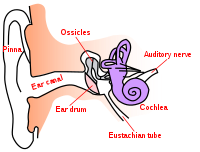
Photo from wikipedia
OBJECTIVES The genetics of sensorineural hearing loss is characterized by a high degree of heterogeneity. Despite this heterogeneity, DNA variants found within SLC26A4 have been reported to be the second… Click to show full abstract
OBJECTIVES The genetics of sensorineural hearing loss is characterized by a high degree of heterogeneity. Despite this heterogeneity, DNA variants found within SLC26A4 have been reported to be the second most common contributor after those of GJB2 in many populations. METHODS Whole exome sequencing and/or Sanger sequencing of SLC26A4 in 117 individuals with sensorineural hearing loss with or without inner ear anomalies but not with goiter from Turkey, Iran, and Mexico were performed. RESULTS We identified 27 unique SLC26A4 variants in 31 probands. The variants c.1673A > G (p.N558S), c.1708-1G > A, c.1952C > T (p.P651L), and c.2090-1G > A have not been previously reported. The p.N558S variant was detected in two unrelated Mexican families. CONCLUSION A range of SLC26A4 variants without a common recurrent mutation underlies SLC26A4-related hearing loss in Turkey, Iran, and Mexico.
Journal Title: International journal of pediatric otorhinolaryngology
Year Published: 2017
Link to full text (if available)
Share on Social Media: Sign Up to like & get
recommendations!